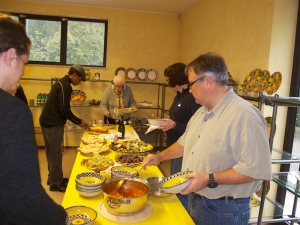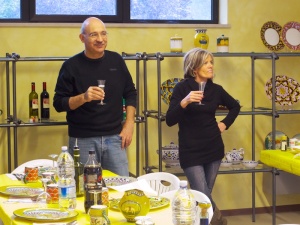Thursday was ceramics day. A rainy, cold, overcast day visiting Deruta, the nearby hill town where the art of ceramics gained a foothold in Italy and dug its roots deep. A place where the art of fusing earth, water, fire and air has been practiced and developed and perfected for nearly eight hundred years. On this day we were exposed to the grand sweep of history of this art form and got to spend time with some of its best modernpractitioners.
 Our day started at the Museo Regionale della Ceramica, Deruta’s regional ceramics museum. In addition to the many interesting facts we learned from our guide Iolanda and the fascinating development of technical skill and artistic prowess that we were able to observe in its collection we learned a very important and personal lesson. You should practice what you preach.
Our day started at the Museo Regionale della Ceramica, Deruta’s regional ceramics museum. In addition to the many interesting facts we learned from our guide Iolanda and the fascinating development of technical skill and artistic prowess that we were able to observe in its collection we learned a very important and personal lesson. You should practice what you preach.
Suzy and I have been in the business of selling ceramics for over a decade now. We preach the gospel of the importance of valuing the handmade, the artistic, the unique. We have spread that message as far and wide as our legs and voices will carry it. We have made it our business, because it is our passion, to watch, to observe, to learn. To question, to inquire, to understand. We have painted (with limited success) and we have watched painters. We have studied designs and we have worked with painters to develop new ones. We have spoken with artists about what inspires them and with customers about what moves them. In short, we have made it our business to know and to understand as well as to appreciate ceramic artistry.
But all the while, in the little hilltop town of Deruta, less than a half hour from our villa, in the tiny Deruta that we visit at least a dozen times a year, is an ex-Franciscan monastery that houses a museum dedicated to all those things that we say we are dedicated to. A museum, or perhaps the museum that presents the story of ceramics to anyone willing to spend four euros and an hour of their time to understand, to see and to appreciate just what the artists of Deruta have accomplished over the centuries. This museum, the Museo Regionale della Ceramica, could not be more accessible nor more inviting. Yet before this week we had never visited it.
Life can be full of regrets if you let it. But I think that is a poor way to live one’s life. I do regret not having visited the Ceramics museum before, however. With a guide such as Iolanda and armed with a little knowledge and even more appreciation, it is possible to marvel at the creation that these central Italians made and contributed to our world. In fact, it is impossible not to marvel. Marvelous. Simply Marvelous.
Photography is not allowed in the museum and so my post cannot include my favorite pieces. But that is ok because even at the current exchange rate of one thousand words to the picture, photos could not do justice to the experience. You must see the simple early fragments, painted in two colors by men who had scooped up clay from the banks of the Tiber river, baked it and then painted it some eight hundred years ago. You must see to appreciate the beginnings of the grotesque designs that swept across Italy at the beginning of the renaissance and which eventually settled in Deruta in the form of the raffaelesco design. You must see to appreciate the convent floor made in maiolica in order to understand what motivated and thrilled these ancient people.
* * *
 And then, if you are lucky, you should drive down the hill from the museum to the lower part of Deruta, the modern neighborhood and visit your friends the Ribigini family. There, if you are like us, Gerardo, Assunta, Claudia and Federico will show you the “modern” ceramics that they toil over day in and day out. They will describe for you how they came to develop the designs that they love, such as how they were inspired by ancient Deruta designs that use peacock feathers. How they fell in love with the yellows and greens used centuries before the invention of the raffaelesco and ricco deruta designs that every trinket seller in Italy hawks and pushes to the throngs of tourists that want to take something “authentic” home with them.
And then, if you are lucky, you should drive down the hill from the museum to the lower part of Deruta, the modern neighborhood and visit your friends the Ribigini family. There, if you are like us, Gerardo, Assunta, Claudia and Federico will show you the “modern” ceramics that they toil over day in and day out. They will describe for you how they came to develop the designs that they love, such as how they were inspired by ancient Deruta designs that use peacock feathers. How they fell in love with the yellows and greens used centuries before the invention of the raffaelesco and ricco deruta designs that every trinket seller in Italy hawks and pushes to the throngs of tourists that want to take something “authentic” home with them.
There you can hear how a plate is transformed from a blank biscotto to a piece of art, a utilitarian object with a tiny soul of its own. There you can see how steady a hand is required, how a clear eye and as equally clear a mind are as important as a paint brush.
 And, if you wish, you should sit down at a table among the shelves displaying the artistry made by this family and share a lunch with them. Sit down and slow down, surrounded by beauty and connecting with them over a simple yet delicious meal, eaten off the artwork that they produce in their daily lives. It is in moments like these that the plates and cruets and goblets stop just being products. They become the objects of our passion. And if you ever get to experience this sort of thing, as our guests did this Thursday, you can begin to see and feel and experience what it is that led Suzy and I to make this our business.
And, if you wish, you should sit down at a table among the shelves displaying the artistry made by this family and share a lunch with them. Sit down and slow down, surrounded by beauty and connecting with them over a simple yet delicious meal, eaten off the artwork that they produce in their daily lives. It is in moments like these that the plates and cruets and goblets stop just being products. They become the objects of our passion. And if you ever get to experience this sort of thing, as our guests did this Thursday, you can begin to see and feel and experience what it is that led Suzy and I to make this our business.
Ci vediamo!
Bill and Suzy





About The Author
Related Posts
Enjoying the Scacciadiavoli Brut
Happy Easter from Umbria